Digital Marketing Finance Model
Digital Marketing Agency Finance Model in Excel provides a structured framework to analyze the financial health of any marketing company’s profitability and expenditure.
Financial Model For A Digital Marketing Agency
This very comprehensive financial model involves projecting the financial performance over a period of 5 years. These models will include three core financial statements: the Income Statement, Cash Flow Statement, and Balance Sheet.
What do you get? 2 Versions in 1 zip file, so you can decide what’s best for you.
Version 1: 5-Year, 3 Statement financial model for tracking and reporting of your Digital Marketing Company financials on a Project Based PAYG Revenue with 5 streams..
Version 2: 5-Year, 3 Statement with a 6 Tier Subscription revenue ‘Managed Service Agreements’. Build Your MSA book as quickly as possible.
And 5 PAYG revenue streams.
Income Statement
The Income Statement (or Profit and Loss Statement) summarizes the company’s revenues, costs, and expenses over a period. For a digital marketing company, the key components are:
Revenue Streams
Service Revenue: Revenue from core services like SEO, PPC, social media management, content marketing, email marketing, and web design.
Retainer Fees: Monthly recurring revenue from clients on long-term contracts.
Project-Based Revenue: One-time revenue from specific campaigns or projects.
Affiliate or Performance-Based Revenue: Revenue tied to performance metrics (e.g., commissions on sales generated through campaigns).
Cost of Goods Sold (COGS)
Labor Costs: Salaries and wages for employees directly involved in service delivery (e.g., campaign managers, designers, content creators).
Software/Tools: Costs of tools like Google Ads, SEMrush, HubSpot, or Canva.
Third-Party Costs: Expenses for outsourcing tasks like graphic design or content writing.
Operating Expenses
Sales and Marketing: Costs for acquiring new clients (e.g., ads, events, partnerships).
General and Administrative (G&A): Overhead costs like office rent, utilities, and administrative salaries.
Research and Development (R&D): Investment in developing new services or improving existing ones.
Other Income/Expenses
Interest Income: Income from investments or savings.
Interest Expense: Costs of debt financing.
Net Income
Gross Profit: Revenue minus COGS.
Operating Profit: Gross profit minus operating expenses.
Net Profit: Operating profit minus taxes and interest.
A 6-tier subscription model for a digital marketing company allows clients to choose from a range of service packages based on their needs, budget, and desired level of support. Each tier offers progressively more features, services, and value.
Tier 1: Basic Digital Marketing Plan
Target Audience: Small businesses or startups with limited budgets.
Price: $500/month
Services Included:
Social Media Management: 2 platforms (e.g., Facebook and Instagram), 3 posts per week per platform.
Basic Analytics: Monthly performance report for social media.
Email Support: Up to 5 email queries per month.
Content Creation: 1 blog post or 2 social media graphics per month.
Ad Campaign Management: $100/month ad spend included (client covers ad spend).
Tier 2: Starter Digital Marketing Plan
Target Audience: Small to medium-sized businesses looking for more comprehensive support.
Price: $1,000/month
Services Included:
Social Media Management: 3 platforms (e.g., Facebook, Instagram, LinkedIn), 5 posts per week per platform.
Content Creation: 2 blog posts or 4 social media graphics per month.
Basic SEO: On-page SEO optimization for 5 pages.
Email Marketing: 1 email campaign per month (up to 500 subscribers).
Analytics: Monthly performance report for social media and website traffic.
Ad Campaign Management: $200/month ad spend included (client covers ad spend).
Support: Email and chat support, up to 10 queries per month.
Tier 3: Growth Digital Marketing Plan
Target Audience: Medium-sized businesses looking to scale their digital presence.
Price: $2,500/month
Services Included:
Social Media Management: 4 platforms (e.g., Facebook, Instagram, LinkedIn, Twitter), 7 posts per week per platform.
Content Creation: 4 blog posts or 8 social media graphics per month.
SEO: On-page and off-page SEO for 10 pages, keyword research, and monthly SEO performance report.
Email Marketing: 2 email campaigns per month (up to 1,000 subscribers).
Ad Campaign Management: $500/month ad spend included (client covers ad spend).
Analytics: Detailed monthly reports for social media, website traffic, and ad performance.
Support: Email, chat, and 1-hour monthly phone consultation.
Tier 4: Professional Digital Marketing Plan
Target Audience: Established businesses with a need for advanced digital marketing strategies.
Price: $5,000/month
Services Included:
Social Media Management: 5 platforms (e.g., Facebook, Instagram, LinkedIn, Twitter, Pinterest), 10 posts per week per platform.
Content Creation: 6 blog posts or 12 social media graphics per month.
SEO: Comprehensive SEO strategy, including technical SEO, backlink building, and monthly performance reports.
Email Marketing: 4 email campaigns per month (up to 2,500 subscribers).
Ad Campaign Management: $1,000/month ad spend included (client covers ad spend).
Analytics: Advanced monthly reports with actionable insights.
Support: Email, chat, and 2-hour monthly phone consultation.
Additional Services: 1 landing page design or A/B testing setup per quarter.
Tier 5: Enterprise Digital Marketing Plan
Target Audience: Large businesses or enterprises requiring a full-service digital marketing solution.
Price: $10,000/month
Services Included:
Social Media Management: 6 platforms (e.g., Facebook, Instagram, LinkedIn, Twitter, Pinterest, YouTube), 15 posts per week per platform.
Content Creation: 8 blog posts or 16 social media graphics per month.
SEO: Full-scale SEO strategy, including technical SEO, content optimization, backlink building, and competitor analysis.
Email Marketing: 6 email campaigns per month (up to 5,000 subscribers).
Ad Campaign Management: $2,000/month ad spend included (client covers ad spend).
Analytics: Custom dashboards and detailed monthly reports with strategic recommendations.
Support: Dedicated account manager, email, chat, and 4-hour monthly phone consultation.
Additional Services: 2 landing page designs or A/B testing setups per quarter, and access to exclusive webinars or training sessions.
Tier 6: Custom Digital Marketing Plan
Target Audience: Large enterprises or businesses with unique needs requiring a tailored approach.
Price: Custom (typically $20,000+/month)
Services Included:
Fully Customized Strategy: Tailored to the client’s specific goals, industry, and budget.
Social Media Management: Unlimited platforms and posts, with a dedicated team.
Content Creation: Unlimited blog posts, graphics, videos, and other content.
SEO: Comprehensive, ongoing SEO strategy with advanced tools and techniques.
Email Marketing: Unlimited email campaigns and subscriber management.
Ad Campaign Management: Custom ad spend allocation and advanced targeting strategies.
Analytics: Real-time dashboards, custom reports, and quarterly strategy reviews.
Support: 24/7 dedicated account manager, priority email, chat, and phone support.
Additional Services: Custom landing pages, A/B testing, influencer partnerships, and more.
Key Features Across All Tiers
Scalability: Clients can upgrade or downgrade tiers as their needs change.
Transparency: Clear pricing and deliverables for each tier.
Flexibility: Custom add-ons available for specific needs (e.g., extra ad spend, additional content).
Performance Tracking: Regular reporting and analytics to measure ROI.
Customer Support: Tiered support levels to match the client’s subscription.
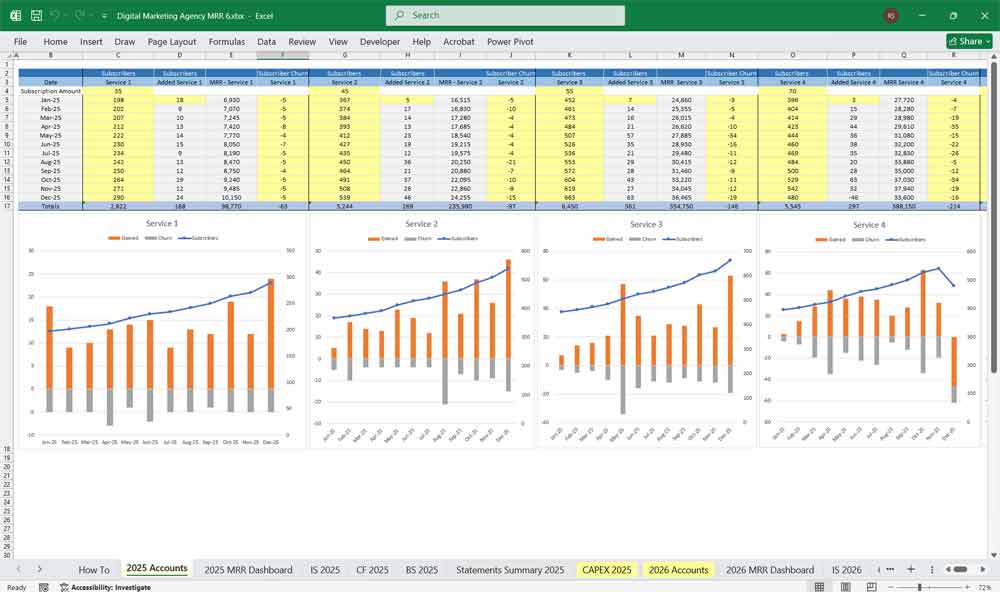
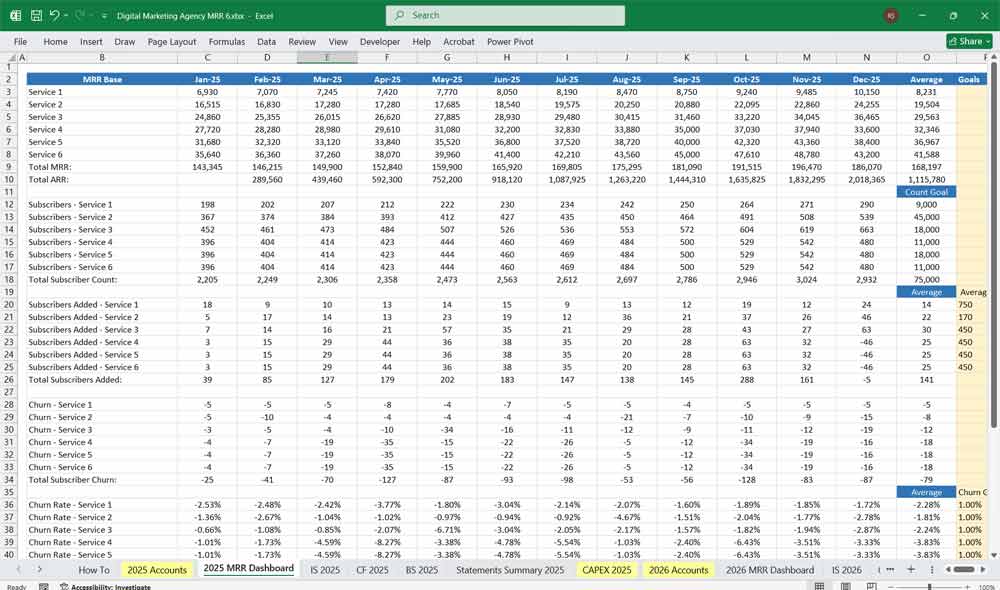
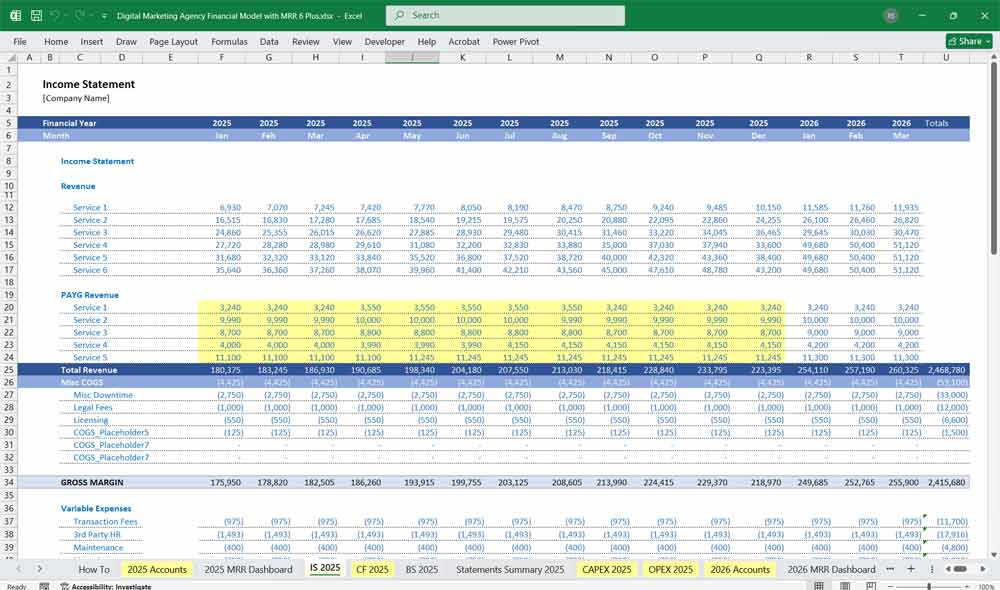
Digital Marketing Cash Flow Statement
The Cash Flow Statement tracks the movement of cash in and out of the business. It is divided into three sections:
Operating Activities
Cash Inflows: Revenue from clients, retainer fees, and other service income.
Cash Outflows: Payments for COGS, operating expenses, and taxes.
Net Cash from Operations: Cash generated from core business activities.
Investing Activities
Capital Expenditures (CapEx): Investments in long-term assets like computers, software licenses, or office equipment.
Acquisitions: Cash spent on acquiring other businesses or assets.
Financing Activities
Debt Financing: Cash inflows from loans or credit lines.
Equity Financing: Cash inflows from investors or shareholders.
Dividends/Repayments: Cash outflows for debt repayments or dividends to shareholders.
Net Change in Cash
The sum of cash flows from operating, investing, and financing activities.
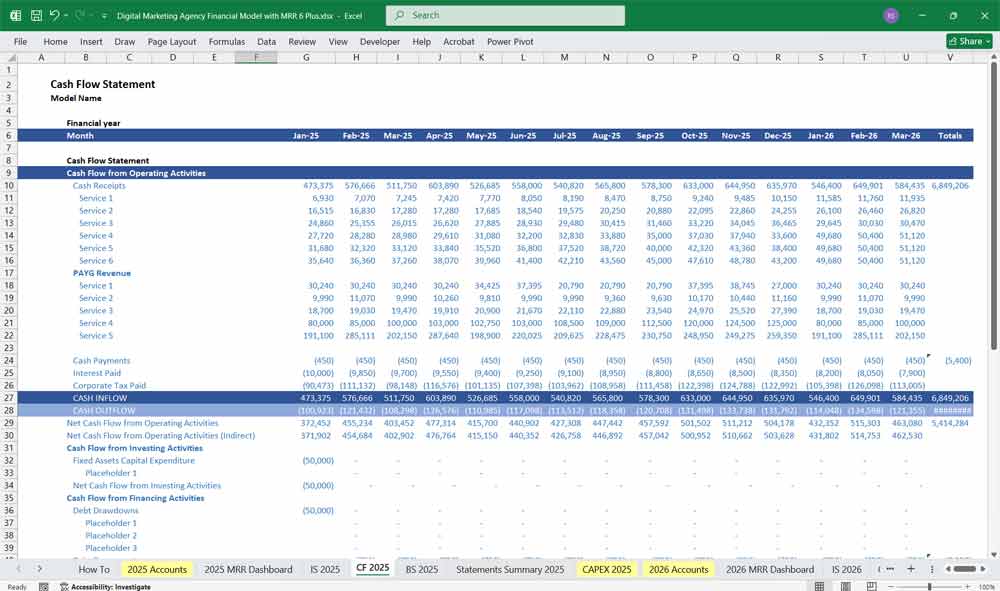
Digital Marketing Balance Sheet
The Balance Sheet provides a snapshot of the company’s financial position at a specific point in time. It consists of three main sections:
Assets
Current Assets:
Cash and cash equivalents.
Accounts receivable (unpaid invoices from clients).
Prepaid expenses (e.g., annual software subscriptions).
Non-Current Assets:
Property, plant, and equipment (PP&E) like office furniture or computers.
Intangible assets (e.g., proprietary software or trademarks).
Liabilities
Current Liabilities:
Accounts payable (unpaid bills to vendors).
Accrued expenses (e.g., unpaid salaries or taxes).
Deferred revenue (payments received for services not yet delivered).
Non-Current Liabilities:
Long-term debt (e.g., business loans).
Equity
Shareholder Equity:
Retained earnings (cumulative net income minus dividends).
Common stock (equity raised from shareholders).
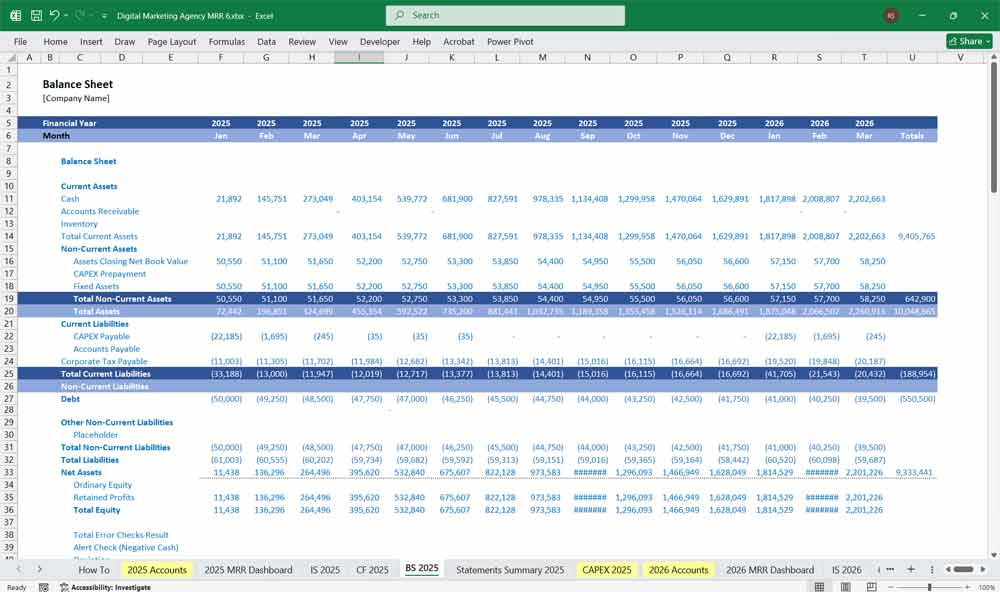
Key Assumptions and Drivers
To build the financial model, you need to define key assumptions and drivers:
Revenue Growth Rate: Based on market research, client acquisition rates, and pricing strategies.
Client Retention Rate: Percentage of clients retained annually.
Pricing Structure: Hourly rates, project fees, or retainer models.
Cost Structure: Fixed vs. variable costs, and economies of scale.
Working Capital: Days sales outstanding (DSO), days payable outstanding (DPO), and inventory turnover (if applicable).
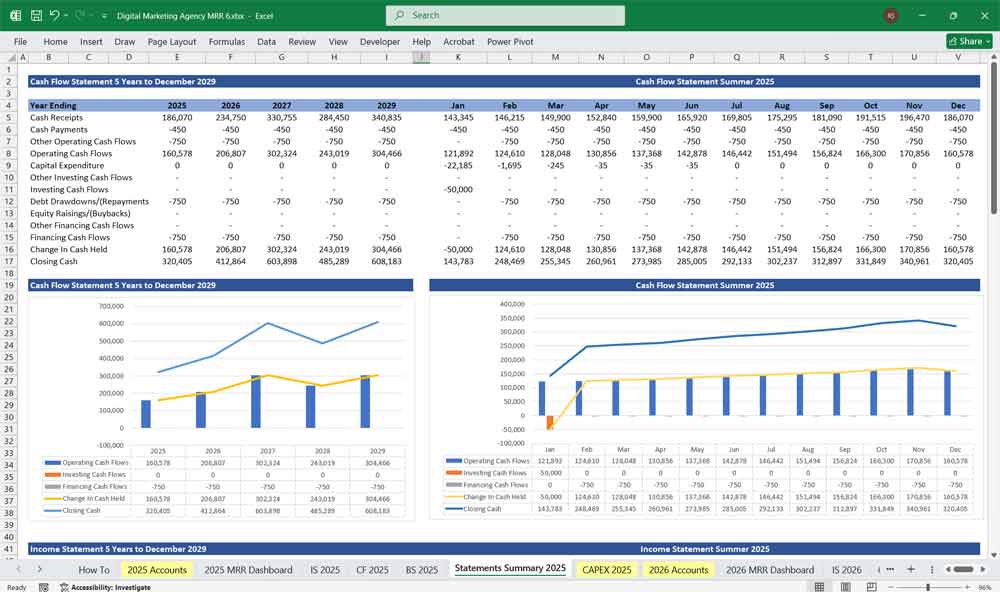
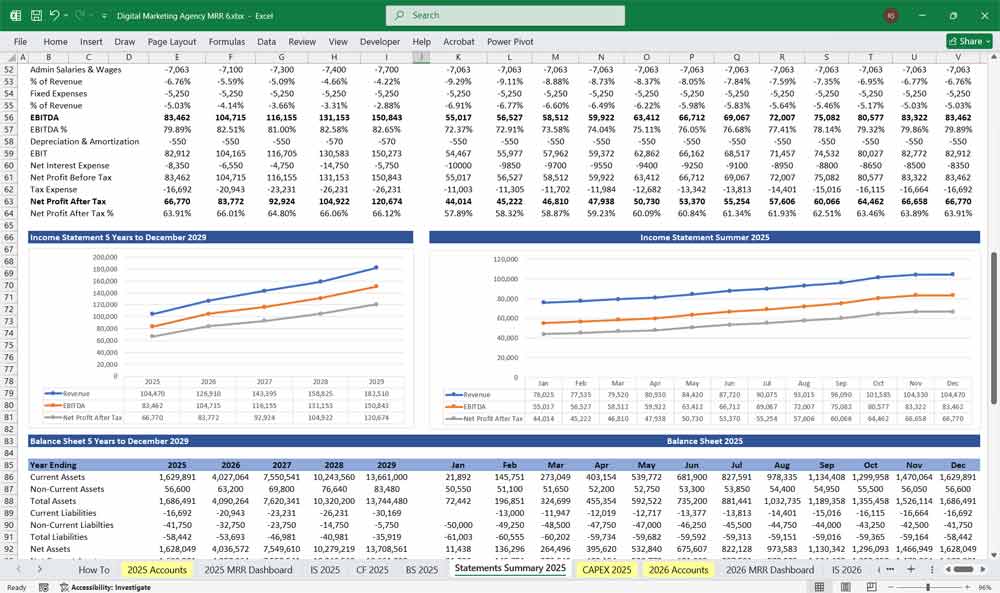
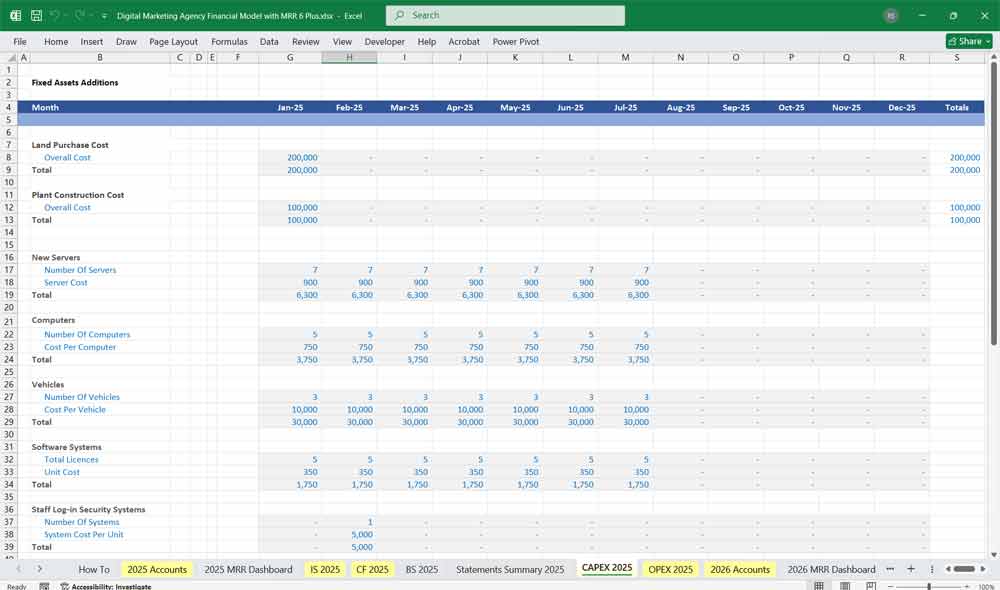
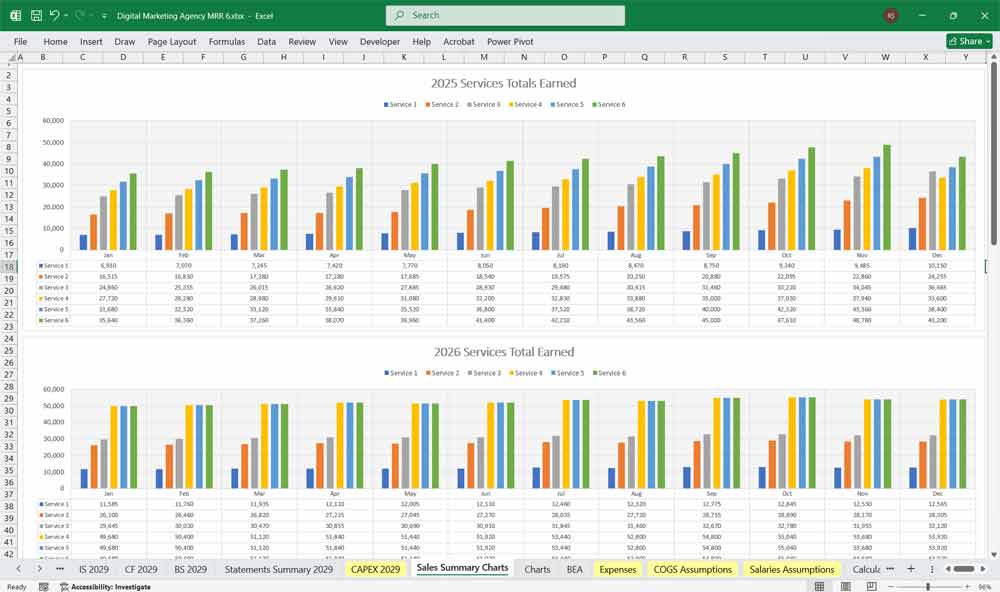
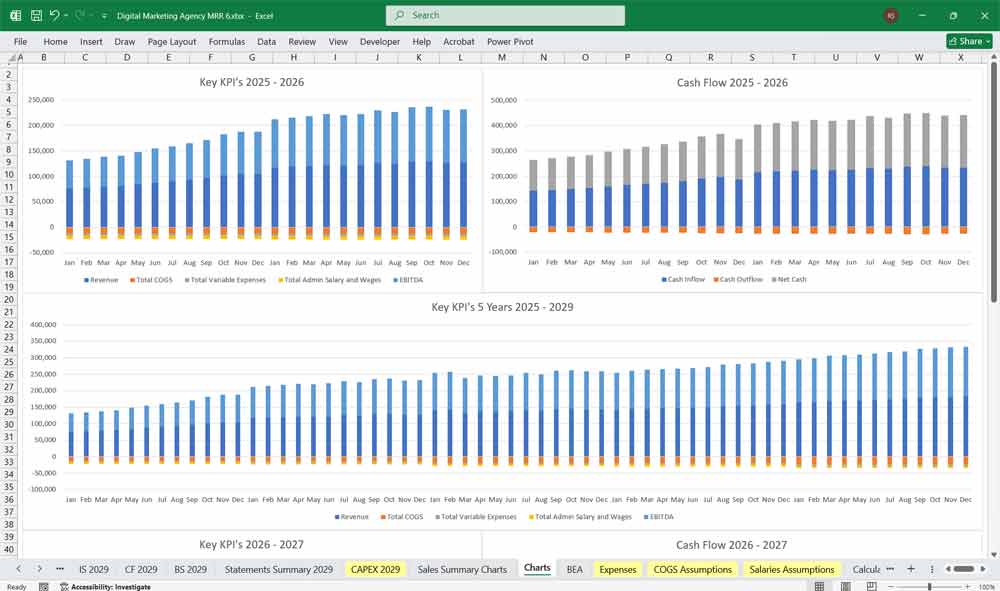
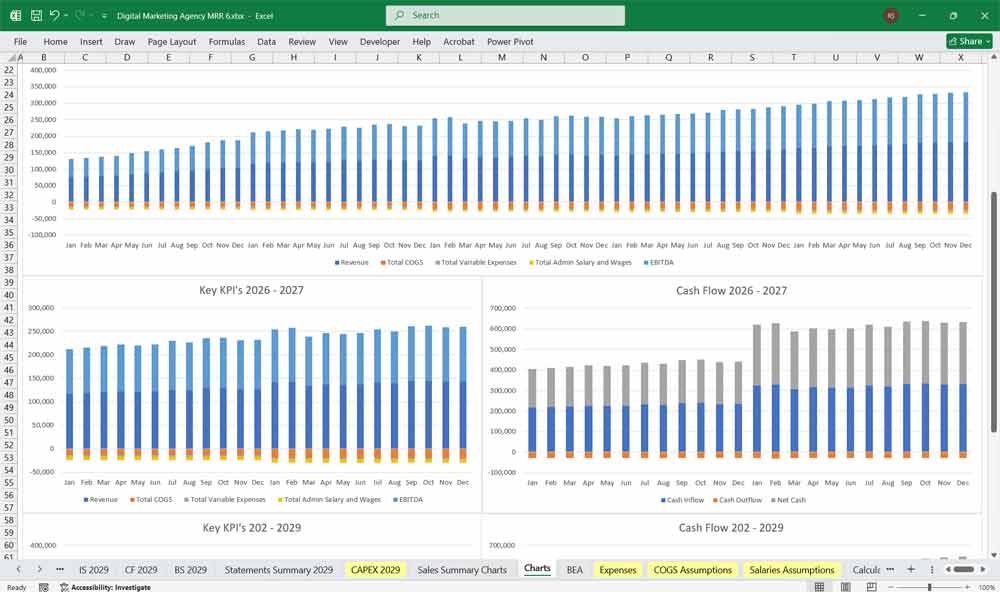
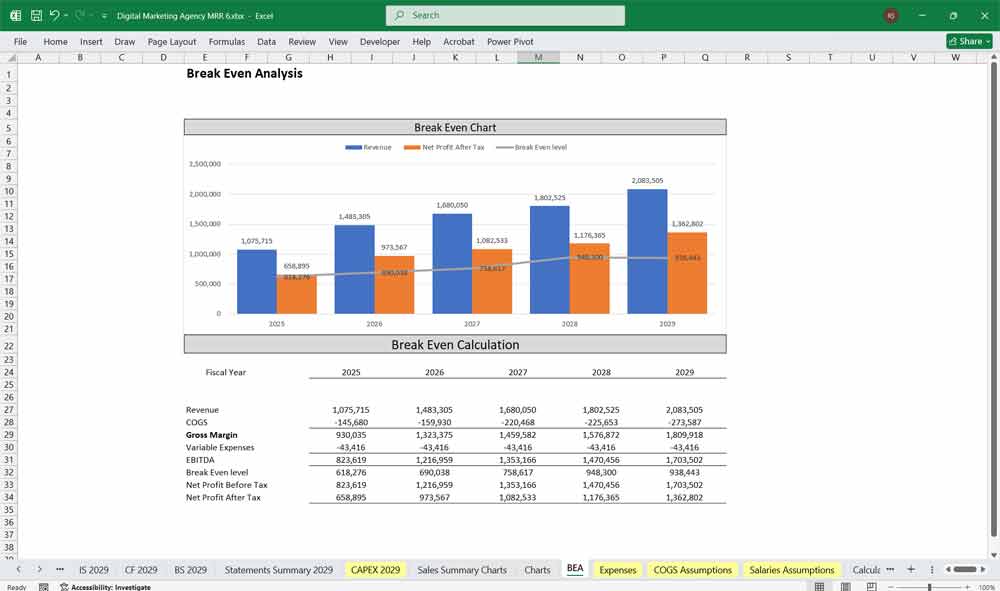
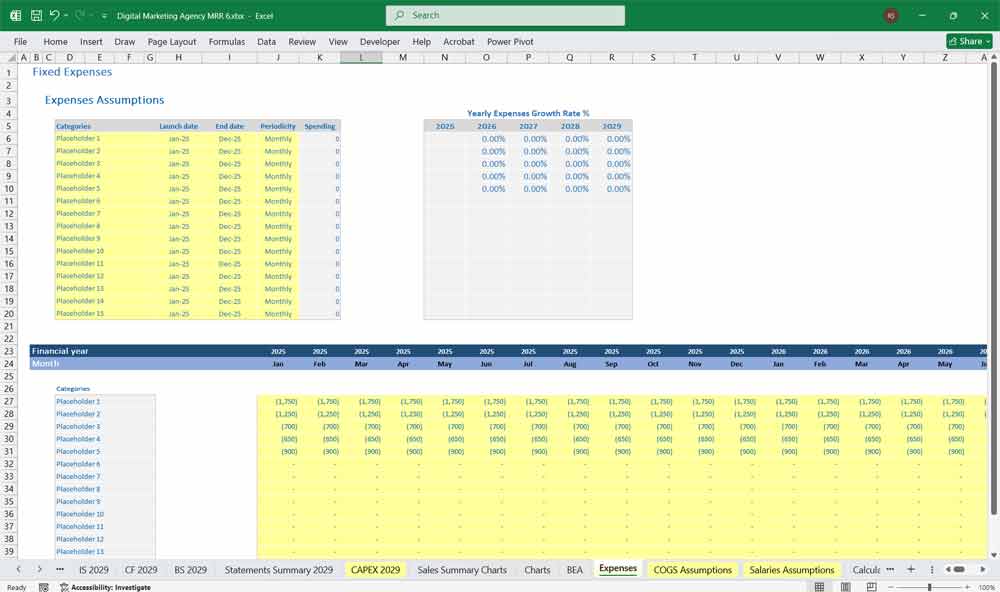
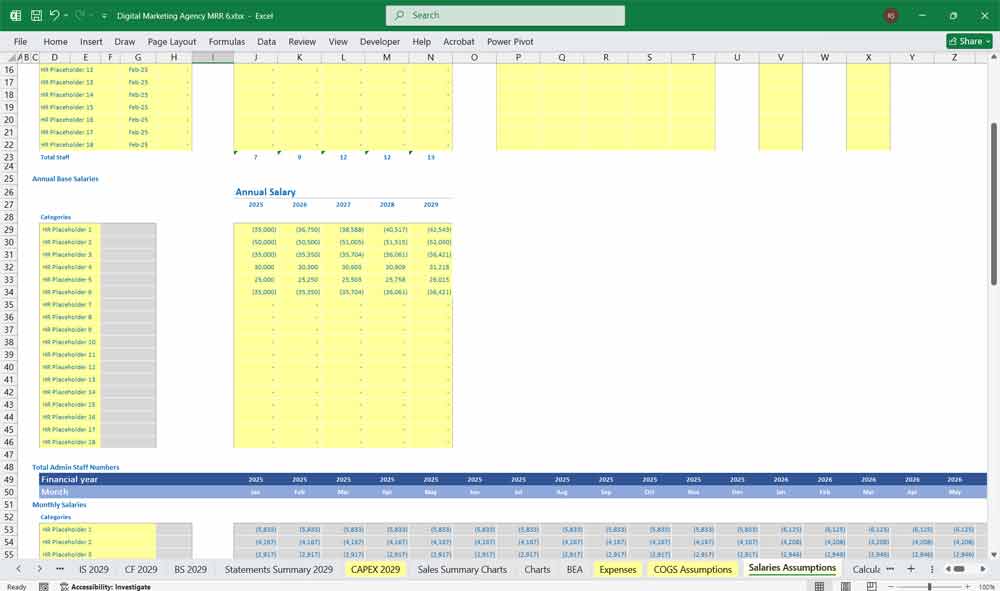
Interconnections Between Statements
Income Statement to Cash Flow: Net income flows into the cash flow statement as the starting point for operating activities.
Cash Flow to Balance Sheet: The net change in cash updates the cash balance on the balance sheet.
Balance Sheet to Income Statement: Interest expense on debt (from the balance sheet) affects net income.
Outputs and Metrics
Profit Margins: Gross, operating, and net profit margins.
Cash Flow Metrics: Free cash flow, cash burn rate (if applicable).
Liquidity Ratios: Current ratio, quick ratio.
Leverage Ratios: Debt-to-equity ratio.
Return on Equity (ROE): Net income divided by shareholder equity.
This financial model will help the digital marketing company plan for growth, manage cash flow, and make informed strategic decisions. It can also be used to attract investors or secure financing by demonstrating the agency’s financial viability.
Download Link On Next Page
